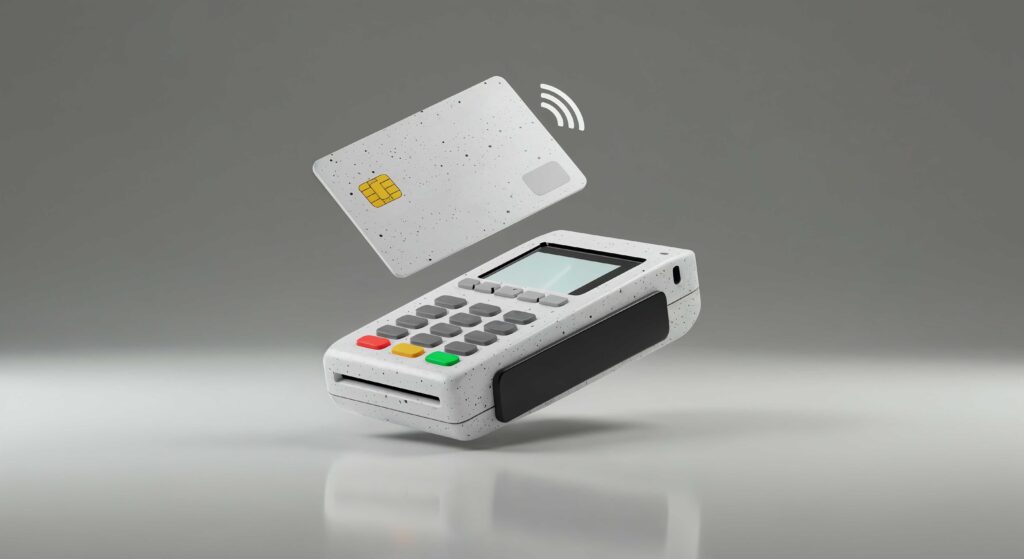If you run a business that accepts card payments, you’ve almost certainly come across a Chip and PIN machine. But what exactly is a Chip and PIN machine, and how does it work?
In simple terms, a Chip and PIN machine — sometimes called a Chip and PIN device or card reader — is a secure terminal that lets your customers pay by inserting their debit or credit card into a slot, then entering their four-digit Personal Identification Number (PIN) to authorize the payment.
The “chip” part refers to the microchip embedded in the customer’s card, which holds encrypted data. The “PIN” is the security code that verifies the cardholder’s identity. Together, this system ensures that each Chip and PIN transaction is secure and extremely difficult to counterfeit.
Understanding Chip and PIN Technology
Chip and PIN technology was introduced in the UK and Europe to tackle the rising cases of card fraud that were common with the old magnetic stripe cards. Unlike swiping a card and signing a receipt, a Chip and PIN device uses EMV standards (Europay, Mastercard, and Visa) to add an extra layer of security to every transaction.
The microchip in the card creates a unique transaction code each time it is used. This code cannot be reused, which helps prevent fraud and data breaches. The PIN entered by the customer acts like a digital signature, confirming that the rightful cardholder is making the payment.
How Do Chip and PIN Machines Work?
When a customer makes a payment, they insert their card into the Chip and PIN machine. The machine reads the information stored on the chip, and the customer types their PIN on the keypad. The device then sends the encrypted data to the payment processor or acquiring bank for authorisation.
If the PIN matches what’s stored on the card’s chip and the funds are available, the transaction is approved within seconds. This process happens behind the scenes and makes every Chip and PIN transaction secure, fast, and convenient for both businesses and customers.
Modern Chip and PIN devices can also process contactless payments for smaller amounts, using NFC (Near Field Communication) technology. This allows customers to tap their card instead of inserting it, but for higher-value transactions, entering the PIN is still required for added security.
Benefits of Using Chip and PIN Devices for Businesses
Adding a Chip and PIN machine to your payment system has multiple benefits. One of the biggest advantages is enhanced security. By using Chip and PIN technology, you reduce the risk of fraud and chargebacks. This protects your revenue and builds trust with your customers.
Customers today expect businesses to offer secure payment methods. A Chip and PIN device reassures them that their sensitive card information is protected. This trust can lead to repeat business and positive word-of-mouth referrals.
Compliance is another important benefit. Businesses that use Chip and PIN machines meet the Payment Card Industry Data Security Standard (PCI DSS) and EMV requirements. This means you’re following best practices for handling card payments and protecting customer data.
Finally, Chip and PIN machines make transactions faster and more efficient. Queues move quickly, your staff spends less time handling cash, and customers appreciate the convenience. Many devices are portable and wireless, so you can take payments anywhere on your premises — whether that’s tableside at a restaurant or at a pop-up event.
Choosing the Right Chip and PIN Machine
Not every business needs the same type of Chip and PIN device. When deciding which machine is best for you, consider factors like portability, connectivity, and integration with your existing point-of-sale (POS) system.
For example, if you run a mobile business or regularly serve customers outdoors, a portable or wireless Chip and PIN machine with 4G or Bluetooth connectivity might be the best choice. Retail stores may prefer countertop machines that connect directly to the till.
It’s also important to compare transaction fees, rental or purchase costs, and customer support. A reliable payment provider should offer transparent pricing and dependable service, so you never miss a sale.
FAQs About Chip and PIN Transactions
What is the difference between Chip and PIN and contactless payments?
Contactless payments allow customers to tap their card on a reader for quick, low-value payments, usually without entering a PIN. Chip and PIN transactions require the card to be inserted and a PIN entered for added security, especially for higher amounts.
Is Chip and PIN more secure than swiping a card?
Yes. Swiping a magnetic stripe card is more vulnerable to cloning and fraud. Chip and PIN adds encryption and a PIN check, which makes it much harder for criminals to misuse card data.
Can I accept mobile payments with my Chip and PIN machine?
Most modern Chip and PIN devices also accept payments from digital wallets like Apple Pay, Google Pay, and other contactless options. This flexibility ensures you never miss a sale.
Conclusion
A Chip and PIN machine is an essential tool for any business that wants to offer secure, reliable card payments. By understanding how Chip and PIN devices work and choosing the right one for your business, you can protect your customers’ data, stay compliant with industry standards, and build lasting trust with every transaction.
If you’re ready to upgrade your payment system, explore the latest Chip and PIN machines from Avantis Direct. Our team can help you find the perfect solution for your unique business needs.
